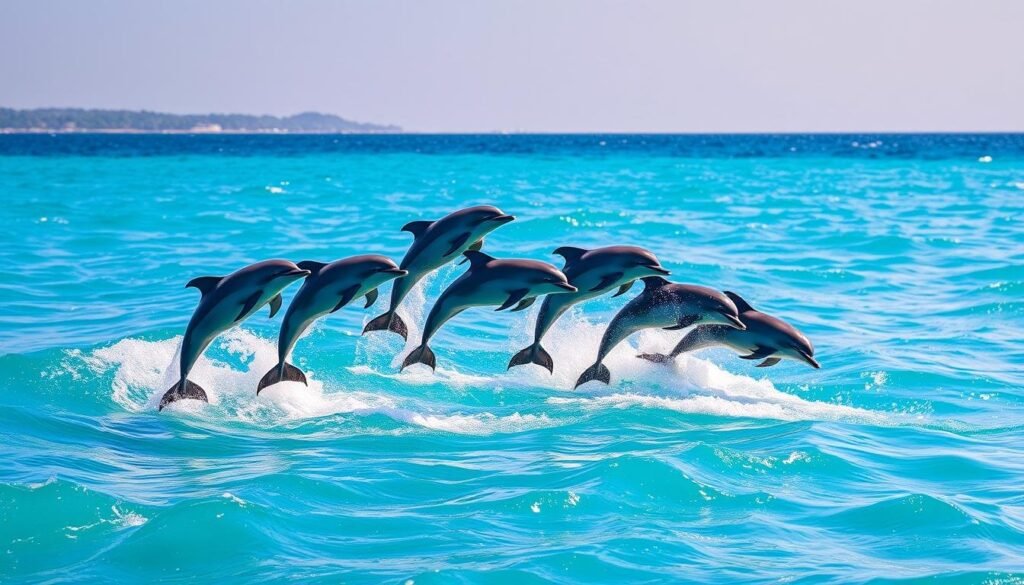Why Dolphins Leap Out of Water? You’ve probably seen dolphins leaping out of the ocean. Their sleek bodies soar through the air with grace and agility. This behavior is a hallmark of these intelligent marine mammals.
When you watch dolphins in their natural habitat, you might wonder why they leap so high. The reasons are many, including communication, social bonding, hunting, and play.
Learning about dolphin behavior helps us understand the complex world of marine life. It sheds light on the intricate dynamics of these highly social creatures.
Contents
- 1 The Spectacular Sight of Dolphins Breaking the Surface
- 2 Why Do Dolphins Leap Out of Water Frequently?
- 3 The Different Types of Dolphin Leaps
- 4 The Science Behind Dolphin Leaping
- 5 Environmental Factors Influencing Leaping Behavior
- 6 Leaping Behaviors Across Different Dolphin Species
- 7 Conclusion: Why Dolphins Leap Out of Water?
- 8 FAQ
- 8.1 Why do dolphins leap out of water?
- 8.2 What are the different types of dolphin leaps?
- 8.3 How do environmental factors influence dolphin leaping behavior?
- 8.4 Do different dolphin species exhibit different leaping behaviors?
- 8.5 What is the science behind dolphin leaping?
- 8.6 Can dolphin leaps be a form of communication?
- 8.7 How do dolphins benefit from leaping out of water?
The Spectacular Sight of Dolphins Breaking the Surface
When a dolphin leaps out of the water, it’s magical. You see their agility and grace as they splash into the air. Their bodies shine in the sunlight.
Watching them breach the surface is mesmerizing. It shows us the beauty and wonder of our oceans. Dolphins seem to defy gravity with their leaps, showing their strength and flexibility.
Their movements are elegant, like they’re dancing on the water. Before diving back, they show off their skills. This isn’t just about physical strength. It’s also a way for them to communicate and connect with each other.
Why Do Dolphins Leap Out of Water Frequently?
Watching dolphins leap out of the ocean makes you wonder why they do it. They leap for many reasons, like socializing, hunting, and navigating.
Visual Signals to Other Pods
Dolphins leap to communicate without words. They signal to their pod by breaching the surface. This can warn others about food or dangers.
Leaping also helps with sound. The splash when they dive back in can be heard by others. It might help with talking or even finding their way.
Herding Fish Schools
Dolphins might leap to herd fish. They slap their tails or make a splash to gather fish. This makes it simpler for them to eat.
Stunning Prey with Re-entry Splashes
Some studies say the splash can stun fish. This makes it easier for dolphins to catch them. It shows how smart dolphins are at hunting.
Learning about these reasons helps us understand dolphins better. It shows how they adapt to their marine environment.
The Different Types of Dolphin Leaps
When you watch dolphins, you’ll see many leaping styles. These styles are key to their behavior. Dolphins show off their smarts and social skills through these leaps.
Dolphins do many kinds of leaps. They might do a breach leap to play or talk. Or, they might do a porpoising leap for speed, like when chasing food or traveling far.
The lobtail leap is when dolphins slap their tails hard on the water. This makes a loud sound that can be heard far away. It’s often a way for them to talk or warn others of danger. Dolphins also do side breaches and backflips to show off their agility.
Learning about these dolphin leaps helps us understand marine life better. It shows how complex dolphin societies are. By studying these leaps, researchers can appreciate dolphins’ social lives more.
The Science Behind Dolphin Leaping
Dolphins leaping out of water is a sight that fascinates marine biologists. They study the physics and biology of dolphin leaps. This helps us understand their behavior and how they live in the ocean.
Reducing Water Resistance
Dolphins leap to cut down on drag and save energy. When they jump out of the water, they avoid the friction that slows them down. This lets them move faster and go further with less effort.
Leaping helps dolphins go faster and travel longer. By jumping out of the water, they can reach speeds that are hard to maintain while swimming. This is great for traveling long distances or chasing prey.
Metabolic Costs of Leaping
Leaping can cost dolphins a lot of energy, but they’ve found ways to make it efficient. Studies show that the energy they spend leaping is often balanced by the speed gains and less drag. This balance is key to understanding how dolphins use energy while moving.
Energy Efficiency in Travel
Dolphins use leaping and other swimming styles to save energy. By porpoising (swimming just below the surface with occasional leaps), they can travel efficiently. This shows how dolphins have adapted to their underwater world.
Learning about dolphin leaping shows their amazing adaptability and complex behavior. By studying marine biology and dolphin behavior, we can learn more about these smart creatures.
Environmental Factors Influencing Leaping Behavior
When you watch dolphins jump out of the water, think about what’s around them. Dolphins can change how they act based on things like water temperature, food, and who they’re with.
Water temperature can change how much energy dolphins have. Prey availability also matters a lot. When there’s plenty of food, dolphins might jump more often as they play and hunt.
| Environmental Factor | Impact on Leaping Behavior |
|---|---|
| Water Temperature | Affects energy levels and activity |
| Prey Availability | Influences frequency of leaps during hunting |
| Social Factors | Encourages leaping as a form of communication |
Knowing about these factors makes you appreciate dolphins more. Their jumping is like a special part of their social and hunting lives. It’s similar to how whale behavior is fascinating.
Leaping Behaviors Across Different Dolphin Species
When you watch dolphins, you’ll see they leap in unique ways. This shows how different they are in the ocean. It’s really interesting to see how they adapt and show their special traits.
The bottlenose dolphin is famous for its high-flying stunts. On the other hand, the spinner dolphin spins up to seven times before diving back into the sea.

| Dolphin Species | Typical Leaping Behavior | Frequency of Leaps |
|---|---|---|
| Bottlenose Dolphin | Acrobatic Leaps | High |
| Spinner Dolphin | Spinning Leaps | Very High |
| Striped Dolphin | Low Breaching | Moderate |
Watching dolphins leap shows how varied they are. It also helps us understand their social lives and how they interact with their surroundings. By studying these leaps, scientists learn more about the ocean’s complex world.
Conclusion: Why Dolphins Leap Out of Water?
Dolphin leaps are a complex behavior. They are influenced by social interaction, hunting strategies, and environmental conditions. Studying dolphin leaps is a key area in marine biology.
This research gives us insights into dolphin behavior, social structures, and habitats. It shows how fascinating and complex their leaping behavior is. The study of dolphin leaps also highlights the need to protect their habitats and marine ecosystems.
Exploring dolphin leaps helps us understand marine biology better. It shows the importance of ongoing research and conservation efforts. This knowledge is crucial for preserving marine life.
See Also: Why Do Rabbits Thump Their Hind Legs When Threatened?
FAQ
Why do dolphins leap out of water?
Dolphins leap for many reasons. They use it to send signals to other dolphins. It also helps them herd fish and stun prey with the splash they make when they dive back in.
What are the different types of dolphin leaps?
Dolphins show off their skills with different leaps. They breach, lobtail, and spyhop. Each leap has its own purpose, showing their diversity and complexity.
How do environmental factors influence dolphin leaping behavior?
The environment affects how dolphins leap. Things like water temperature and the availability of food play a big role. Dolphins adjust their leaps based on their surroundings.
Do different dolphin species exhibit different leaping behaviors?
Yes, each dolphin species has its own way of leaping. This shows their unique traits and how they adapt to their environments.
What is the science behind dolphin leaping?
Dolphin leaping is a science marvel. They leap to cut through water, go faster, and use less energy. It’s a display of their amazing biology and physics.
Can dolphin leaps be a form of communication?
Yes, dolphin leaps can be a way to communicate. They send visual signals to other dolphins. It’s part of their social behavior and how they interact with each other.
How do dolphins benefit from leaping out of water?
Leaping helps dolphins in many ways. It improves their communication and hunting skills. It also helps them save energy, showing their intelligence and adaptability.

Zyair Larson, based in Denver, Colorado, has over 12 years of experience studying animal behavior. He has worked with the World Wildlife Fund (WWF) and National Geographic, researching wildlife and sharing insights on animal habits globally.

